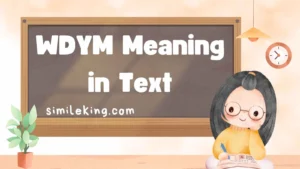Similes are an important part of the English language, helping students develop their creativity and understanding of comparisons.
In this article, we’ll provide a “similes worksheet for grade 4 with answers,” helping students better grasp this essential literary device.
We’ll explore a variety of simile examples and how they can be used effectively in both written and spoken language.
Whether you’re a teacher looking for resources to use in the classroom or a parent helping your child at home, this guide offers 25+ similes and corresponding worksheets, each complete with answers for easier learning.
Introduction to Similes for Grade 4 Students
A simile is a figure of speech that compares two different things using words like “as” or “like.” For example, saying, “as brave as a lion” compares someone’s bravery to the courage of a lion. This device helps make language more vivid and easier to understand, as it paints a clear picture for the reader or listener.
Similes can be playful, descriptive, and insightful, and they are widely used in both everyday conversations and more formal contexts. The goal of this worksheet is to help grade 4 students develop a solid understanding of similes and how to use them in different contexts.
Types of Similes and Their Usage
1. Descriptive Similes
These similes are used to vividly describe a person, place, or thing, enhancing the imagery in writing.
- Examples:
- Her hair is as shiny as gold.
- The room was as cold as ice.
2. Similes for Emotions and Feelings
These similes help express emotions, making it easier to convey complex feelings.
- Examples:
- He was as angry as a bull.
- Her heart was as light as a feather.
3. Similes for Size or Quantity
These similes are great for making comparisons about size, volume, or extent.
- Examples:
- The elephant was as big as a house.
- The mountain was as tall as the sky.
4. Similes for Speed or Time
These types of similes focus on comparing the speed of action or the passage of time.
- Examples:
- He ran as fast as a cheetah.
- The minutes passed as slowly as a snail.
25+ Similes for Grade 4 Students
Below are 25+ simile examples for grade 4 students to understand and use in their writing and conversations. These will help build their vocabulary, improve their writing skills, and allow them to make more creative comparisons.
Simile Examples for Grades 4 and Above
- As bright as the sun.
- As quiet as a mouse.
- As fast as a race car.
- As sweet as honey.
- As cold as a snowflake.
- As hard as a rock.
- As clean as a whistle.
- As smooth as silk.
- As busy as a bee.
- As sharp as a knife.
- As light as a feather.
- As tall as a giraffe.
- As strong as an ox.
- As slow as a tortoise.
- As hot as a stove.
- As soft as cotton.
- As heavy as a ton of bricks.
- As sweet as sugar.
- As deep as the ocean.
- As smooth as butter.
- As colorful as a rainbow.
- As bright as a star.
- As dark as night.
- As sweet as a strawberry.
- As cute as a kitten.
- As dry as a bone.
Simile Worksheet for Grade 4 Students
Now that we’ve explored some examples of similes, let’s take a look at a worksheet designed to help grade 4 students practice creating and identifying similes.
Worksheet Instructions:
Read the sentence carefully and fill in the blanks with a suitable simile. Use the options provided in the word bank.
Word Bank:
- as fast as a cheetah
- as slow as a snail
- as soft as a pillow
- as bright as a star
- as strong as an ox
Example:
- The wind was _____. (Answer: as fast as a cheetah)
Questions:
- The baby’s skin is _____. (Answer: as soft as a pillow)
- His speech was _____. (Answer: as slow as a snail)
- She smiled _____. (Answer: as bright as a star)
- The weightlifter was _____. (Answer: as strong as an ox)
Answer Key:
- as soft as a pillow
- as slow as a snail
- as bright as a star
- as strong as an ox
12 Polite and Casual Alternatives to “Similes Worksheet for Grade 4 with Answers”
When discussing educational materials, especially for a younger audience like grade 4 students, it’s useful to know a variety of ways to phrase common terms while maintaining the appropriate tone. Here are twelve polite, professional, and casual alternatives to the phrase “similes worksheet for grade 4 with answers.”
Polite Alternatives:
- Similes Practice Sheet for Grade 4 Students
- Grade 4 Simile Learning Guide
- Worksheet for Understanding Similes in Grade 4
- Interactive Simile Exercises for Young Learners
- Simile Identification and Practice Sheet for Grade 4
- Simile Exploration Worksheet for Fourth Graders
Casual Alternatives:
- Similes Fun Sheet for Grade 4
- Grade 4 Simile Fun Sheet
- Simile Practice for Kids in Grade 4
- Worksheet of Cool Similes for Grade 4
- Simile Matching Sheet for Fourth Grade
- Easy Similes Worksheet for Grade 4 Kids
How to Choose the Best Alternative Based on Context and Tone
When selecting an alternative phrase for “similes worksheet for grade 4 with answers,” it’s important to consider the audience and the tone of the conversation. Here are some tips for making the best choice:
- Formal Settings (School Reports, Teaching Materials): If you’re writing for a formal educational setting, you should lean toward more polite and professional alternatives like “Similes Practice Sheet for Grade 4 Students” or “Simile Identification and Practice Sheet for Grade 4.”
- Casual Conversations (Parent-Teacher Meetings, Informal Blog Posts): For informal or friendly contexts, you can use more relaxed phrases such as “Simile Fun Sheet for Grade 4” or “Easy Similes Worksheet for Grade 4 Kids.”
- Optimizing for SEO and Google AdSense: Choose alternatives that maintain clarity and relevance to the topic. Avoid overly complex language or keyword stuffing. Phrases like “Simile Learning Guide” and “Simile Exploration Worksheet” are optimized for both readability and search engine optimization (SEO).
Conclusion
Similes are a fantastic way to make language more expressive and engaging for young learners. This worksheet offers a valuable resource for grade 4 students to explore similes and improve their writing skills. By practicing with these similes, students will not only enhance their vocabulary but also become more creative in their use of language.
Remember to adapt your language based on the context—whether it’s formal or casual—and always choose phrases that suit your audience. We hope this guide and worksheet help make learning similes a fun and rewarding experience for both students and teachers.





